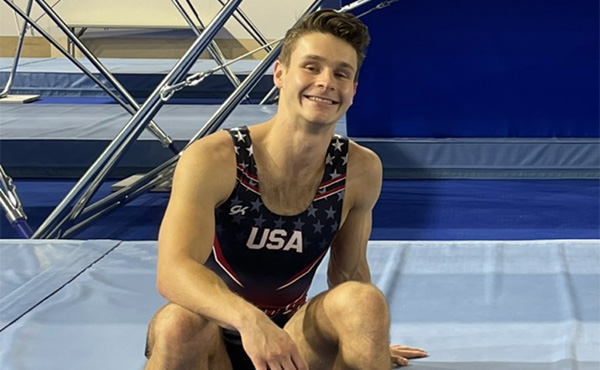
By Jazzy Kerber
Aliaksei Shostak has come a long way since being a kid who bounced on the trampoline to get out of doing pommel horse drills.
Both of Shostak’s parents are artistic gymnastics coaches, and he remembers messing around in the gym starting at age four. When the family moved to the United States from their native Belarus two years later, Shostak continued playing in the gym while he waited for his parents to finish work.
He started out doing artistic gymnastics, following in his parents’ footsteps, but his heart lay elsewhere. Shostak remembers one particular day when his dad gave him a pommel horse exercise to complete. Frustrated when he couldn’t perform it well, Aliaksei ran off to jump on a nearby trampoline.
"It was like freedom," Shostak said. "You feel weightless in a way."
The move toward trampoline marked a turning point. Shostak loved trampoline, and he also had a talent for it. But still, he started out training at a gym that didn’t specialize in his chosen discipline. As a result, Shostak self-taught many of his skills–and not always correctly, remembers his current coach, Dmitri Poliaroush.
In 2011, recognizing that his son’s progress had stalled, Aliaksei’s dad suggested that he train a couple of hours away in Lafayette, Louisiana with Poliaroush. The coaches knew each other from their own athletic careers in Belarus. Poliaroush had already coached several top U.S. trampoline athletes (he currently coaches Nicole Ashinger, among others), and under his guidance, Aliaksei improved significantly.
"The kid was very talented and you could tell from the beginning," Poliaroush said. "But when he came [to Lafeyette] he had only three doubles. He progressed tremendously from that."
Not only did Shostak increase his difficulty significantly, but he also improved his technique, learning to twist in the same direction on all of his skills, rather than varying the direction, as he’d previously taught himself to do.
Shostak said he now views technique as one of his biggest strengths. Poliaroush agreed.
"Aliaksei is very strong technically," Poliaroush said. "He is beautiful to watch. He has lightness and speed."
As time went on, Shostak focused on additional ways to improve his performance. "Back in 2016, when I didn’t make the Olympic team, I was very upset right then and there," he told Flo Gymnastics last month. "I had an epiphany that night when I didn’t make it. I was like, ‘You have to change. You have to become a better version of yourself.’ I was like, ‘Let’s strap up our boots and get going.’"
Part of the change was physical; Shostak has worked with personal trainer Robert Adams to make his jumps more powerful and explosive. But part of it has also been mental. Shostak said that when the pandemic forced him to temporarily decrease his training, he took it as a chance to work with a sports psychologist and practice mental training techniques like visualization.
"Trampoline is a very mental sport," Shostak said. "Visualization is crucial because you have one shot per routine." Unlike in many other sports, a trampoline athlete who falls in the middle of a routine cannot continue with their other skills afterward.
Shostak has used mental strength across his training, focusing on doing each and every thing the right way.
"Aliaksei is probably the most hyper-focused athlete that I’ve worked with," Adams said. "The minute he walks in, we immediately attack what we’re doing, and he doesn’t deviate."
Shostak aims to apply all of his preparation–both physical and mental–in Tokyo this week.
"I’m just kind of doing what I know how to do, you know, calm, collected, and see where I land," he said. "I know I can be a contender for a medal if I hit a certain difficulty routine."
And at 26, he said he hopes to continue competing after Tokyo and shoot for the next Olympics, too.




